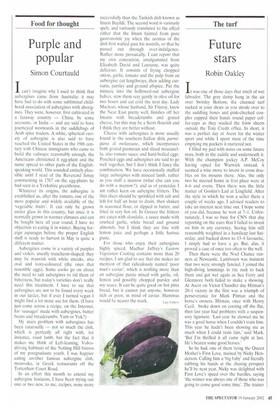Purple and popular
Simon Courtauld
Ican't imagine why I used to think that aubergines came from Australia: it may have had to do with some subliminal childhood association of aubergines with aborigines. They were, however, first cultivated in a faraway country — China, by some accounts, or India — and are said to have journeyed westwards in the saddlebags of Arab spice traders. A white, spherical variety of aubergine is also said to have reached the United States in the 19th century with Chinese immigrants who came to build the railways; reasonably enough, the Americans christened it egg-plant and the name spread to other parts of the Englishspeaking world. This sounded entirely plausible until I read of the Reverend Ismay commenting in 1767 on the egg-plants he had seen in a Yorkshire greenhouse.
Whatever its origins, the aubergine is established as, after the tomato, one of the most popular and widely available of the 'vegetable fruits'. It can only be grown under glass in this country, but since it is normally grown in warmer climates and can be bought here all year round, I have no objection to eating it in winter. Buying foreign asparagus before the proper English stuff is ready to harvest in May is quite a different matter.
Aubergines come in a variety of purples and violets, usually truncheon-shaped; they may be mauvish with white streaks, also oval and ivory-coloured (the ones that resemble eggs). Some cooks go on about the need to salt aubergines to rid them of bitterness, but today's varieties don't really need this treatment. I have to say that aubergines are not to be found every week in our larder, but if ever I turned vegan I might find a lot more use for them. (I have just come across a recipe, on the Internet, for 'sausages' made with aubergines. butter beans and breadcrumbs. Yum or Yuk?) My main problem with aubergines has been ratatouille — not so much the dish, which is perfectly all right with, for instance, roast lamb, but the fact that it makes me think of Left-leaning, Volvodriving habitués of the Notting Hill bistros of my postgraduate youth. I was happier eating another famous aubergine dish, moussaka, in Greek restaurants off the Tottenham Court Road.
In an effort this month to extend my aubergine horizons, I have been trying out one or two new, to me, recipes, none more successfully than the Turkish dish known as Imam Bayildi. The second word is variously spelt, and variously translated to the effect either that the Imam fainted from pure gastronomic joy when the aromas of the dish first wafted past his nostrils, or that he passed out through over-indulgence. Rather more prosaically, I can report that my own concoction, amalgamated from Elizabeth David and Larousse, was quite delicious. It consists of frying chopped onion, garlic, tomato and the pulp from an aubergine cut lengthways, then adding currants, parsley and ground allspice. Put the mixture into the hollowed-out aubergine halves, stew them very gently in olive oil for two hours and eat cold the next day. Lady Maclean, whose husband, Sir Fitzroy, knew the Near East pretty well, finishes off her Imams with breadcrumbs and grated cheese, but this may be a Scots flourish and I think they are better without.
Cheese with aubergines is more usually found in the southern Italian dish, parmigiana di melanzane, which incorporates both grated parmesan and sliced mozzarella, also tomato sauce and hard-boiled eggs. Poached eggs and aubergines are said to go well together, but I don't think I fancy the combination. We have occasionally stuffed large aubergines with minced lamb, rather as you stuff a marrow (what else can you do with a marrow?); and as of yesterday I am rather keen on aubergine fritters. The thin slices should be sprinkled with salt and left for half an hour to drain, then shaken in seasoned flour, or dipped in batter, and fried in very hot oil. In Greece the fritters are eaten with skordalia, a sauce made with crushed garlic, white bread and ground almonds, but I think they are fine with lemon juice and perhaps a little harissa paste.
For those who enjoy their aubergines highly spiced, Madhur Jaffrey's Eastern Vegetatian Cooking contains more than 20 recipes. I am glad to see that she makes no mention of that ridiculously named 'poor man's caviar', which is nothing more than an aubergine purée mixed with garlic, oil, lemon and possibly chopped parsley and soy sauce. It can be quite good on hot pitta bread, but it cannot put anyone, however rich or poor, in mind of caviar. Hummus
would be nearer the mark. Lucy Vickery






























































 Previous page
Previous page